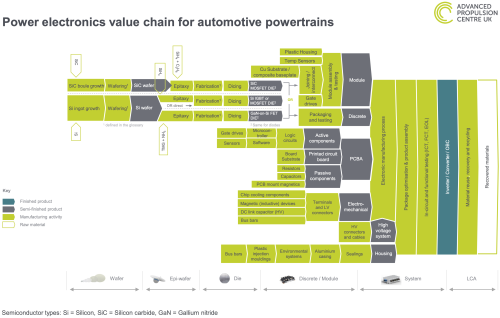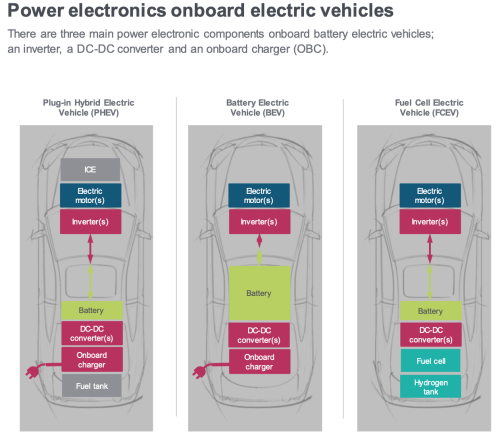APC has also published a separate power electronics insights report.

APC says that this is the first document of its kind to demonstrate the complete value chain; identifying what’s needed to build a robust end-to-end UK supply chain. It will be a valuable tool to support industry, academia, government, and the investment community navigate what’s required and highlight where the gaps are. As the UK moves to secure its electric vehicle (EV) manufacturing industry, the PE value chain will play a vital role in identifying where action is needed to anchor the value-add in the UK and informs upskilling and training requirements.
Power electronics are fundamental to electric vehicles. At the heart of these devices are semiconductors. Semiconductors are needed for a wide range of applications on a vehicle, ranging from the entertainment system to power-steering. Crucially, they are an integral part of any electrified powertrain, supplying and controlling the current and voltage throughout the drive system. Electric vehicles use 30% more chips than ICE (internal combustion engine) vehicles—meaning shortages will impact on 2030 manufacturing targets.
There are three main power electronic components on board battery electric vehicles; an inverter, a DC-DC converter, and an onboard charger (OBC).
An inverter converts DC power from the vehicle’s battery to AC power to drive the electric motor. These high-power devices (30-400 kW) are either standalone or integrated with the electric motor into an electric drive unit (EDU).
A DC-DC converter on a BEV or PHEV decreases (steps-down) voltage from the high voltage battery, e.g., 400-800 V, to low voltages as needed by the vehicle’s auxiliary systems. These are typically low power devices (3-7 kW), but high power on a FCEV.
An onboard charger (OBC) takes AC power from the electrical grid and converts it to DC for storage on the vehicle’s battery. These are typically rated at 3-23 kW.

Source: APC Power electronics insights report
Key semiconductor terminology includes:
Wafer – A wafer (also called a slice or substrate) is a thin slice of semiconductor, used for the fabrication of integrated circuits and, in photovoltaics, to manufacture solar cells.
Epi-wafer – An epitaxial wafer (commonly called epi-wafer) is a wafer of semiconducting material made by epitaxial growth (epitaxy) for use in photonics, microelectronics, spintronics, or photovoltaics. Layers can be of different materials, suited to its intended function.
Die – An electronic die is a small block of semiconducting material upon which integrated circuit parts and functions are fabricated.
MOSFET – A metal-oxide semiconductor field-effect transistor is a device which can amplify and switch electronic signals.
Power module – A power module is an assembly containing several power components, mostly power semiconductor devices, internally interconnected to perform a power conversion function.
Silicon carbide (SiC) semiconductors are growing in popularity. SiC MOSFETs offer huge potential for power electronic systems due to their reduced conduction and switching losses and ability to withstand higher junction temperatures.
By operating at higher switching frequencies and voltages of 800V +, SiC provides a compounding effect from improved power conversion efficiencies of 5-15% and significant weight savings to the electric motor, cabling and the cooling system.
Although SiC inverters cost more to produce than Si inverters, efficiency gains across the complete powertrain system can reduce the battery size by 3-5% (for a given range), offering a valuable route to offsetting costs and reducing critical battery material demand.
APC has identified that with a focus on SiC and gallium nitride (GaN) semiconductors, the UK has a credible chance of creating an end-to-end supply chain. Silicon carbide is the preferred front runner for future electric vehicle power distribution, control, and supply management. It is cost-effective when its benefits are applied across the powertrain system, providing power efficiency gains, and reducing the size of motors and the battery pack.